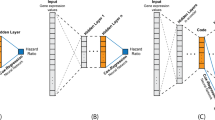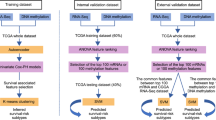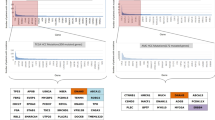Abstract
Accurate prediction is helpful to the treatment of liver cancer. In this paper, we propose a method based on a combination of deep learning and network fusion to predict the survival subtype of liver cancer, of which Univariate Cox-PH regression model was used twice. We integrated RNA sequencing, miRNA sequencing, DNA methylation data and clinical data of liver cancer from TCGA to infer two survival subtypes. We then also constructed an XGBoost supervised classification model to predict the survival subtype of the new sample. Experimental results show that our model gives two subgroups with significant survival differences and Concordance index. We also use two additional confirmation cohorts downloaded from the GEO database to verify our multi-omics model. We found highly expressed stemness marker genes CD24, KRT19 and EPCAM and the tumor marker gene BIRC5 in two survival subgroups. Our method has great clinical significance for the prediction of HCC prognosis.
Access this chapter
Tax calculation will be finalised at checkout
Purchases are for personal use only
Similar content being viewed by others
References
Torre, L.A., Bray, F.I., Siegel, R.L., Ferlay, J., Lortettieulent, J., Jemal, A.: Global cancer statistics, 2012. CA Cancer J. Clin. 65, 87–108 (2012)
Abbosh, C., et al.: Phylogenetic ctDNA analysis depicts early-stage lung cancer evolution. Nature 545, 446–451 (2017)
Di Bisceglie, A.M., Rustgi, V.K., Hoofnagle, J.H., Dusheiko, G.M., Lotze, M.T.: Hepatocellular carcinoma. Ann. Int. Med. 108, 390–401 (1988)
Hoshida, Y., et al.: Integrative transcriptome analysis reveals common molecular subclasses of human hepatocellular carcinoma. Can. Res. 69, 7385–7392 (2009)
Goossens, N., Sun, X., Hoshida, Y.: Molecular classification of hepatocellular carcinoma: potential therapeutic implications. Hepatic Oncol. 2, 371–379 (2015)
Zhu, X., Yao, J., Zhu, F., Huang, J.: WSISA: making survival prediction from whole slide histopathological images. In: Computer Vision and Pattern Recognition, pp. 6855–6863 (2017)
Sun, D., Li, A., Tang, B., Wang, M.: Integrating genomic data and pathological images to effectively predict breast cancer clinical outcome. Comput. Methods Programs Biomed. 161, 45–53 (2018)
Dong, R., et al.: Predicting overall survival of patients with hepatocellular carcinoma using a three-category method based on DNA methylation and machine learning. J. Cell Mol. Med. 23, 3369–3374 (2019)
Chaudhary, K., Poirion, O., Lu, L., Garmire, L.X.: Deep learning-based multi-omics integration robustly predicts survival in liver cancer. Clin. Cancer Res. 24, 1248–1259 (2017)
Cox, D.R.: Regression models and life-tables. J. Roy. Stat. Soc.: Ser. B (Methodol.) 34, 187–202 (1972)
Ng, A.Y., Jordan, M.I., Weiss, Y.: On spectral clustering: analysis and an algorithm. In: Neural Information Processing Systems, pp. 849–856 (2001)
Wang, B., et al.: Similarity network fusion for aggregating data types on a genomic scale. Nat. Methods 11, 333–337 (2014)
Buhmann, M.D.: Radial Basis Functions: Theory and Implementations. Cambridge University Press, Cambridge (2003)
Wang, B., Jiang, J., Wang, W., Zhou, Z., Tu, Z.: Unsupervised metric fusion by cross diffusion. In: Computer Vision and Pattern Recognition, pp. 2997–3004 (2012)
Yang, X., Bai, X., Latecki, L.J., Tu, Z.: Improving shape retrieval by learning graph transduction. In: Forsyth, D., Torr, P., Zisserman, A. (eds.) ECCV 2008. LNCS, vol. 5305, pp. 788–801. Springer, Heidelberg (2008). https://doi.org/10.1007/978-3-540-88693-8_58
Dash, M., Liu, H.: Feature selection for classification. In: Intelligent Data Analysis, pp. 131–156 (1997)
Hinton, G.E., Salakhutdinov, R.: Reducing the dimensionality of data with neural networks. Science 313, 504–507 (2006)
Bland, J.M., Altman, D.G.: Survival probabilities (the Kaplan-Meier method). Br. Med. J. 317, 1572–1580 (1998)
Steck, H., Krishnapuram, B., Dehingoberije, C., Lambin, P., Raykar, V.C.: On ranking in survival analysis: bounds on the concordance index. In: Neural Information Processing Systems, pp. 1209–1216 (2007)
Kim, S.M., et al.: Sixty-five gene-based risk score classifier predicts overall survival in hepatocellular carcinoma. Hepatology 55, 1443–1452 (2012)
Acknowledgments
This work was supported by grants from the NSFC projects Grant (No. U1611263, U1611261 and 61932018) and the National Natural Science Foundation of China (Nos. U19A2064 and 61873001).
Author information
Authors and Affiliations
Corresponding authors
Editor information
Editors and Affiliations
Rights and permissions
Copyright information
© 2020 Springer Nature Switzerland AG
About this paper
Cite this paper
Wang, Z. et al. (2020). An Integration Framework for Liver Cancer Subtype Classification and Survival Prediction Based on Multi-omics Data. In: Huang, DS., Premaratne, P. (eds) Intelligent Computing Methodologies. ICIC 2020. Lecture Notes in Computer Science(), vol 12465. Springer, Cham. https://doi.org/10.1007/978-3-030-60796-8_21
Download citation
DOI: https://doi.org/10.1007/978-3-030-60796-8_21
Published:
Publisher Name: Springer, Cham
Print ISBN: 978-3-030-60795-1
Online ISBN: 978-3-030-60796-8
eBook Packages: Computer ScienceComputer Science (R0)




